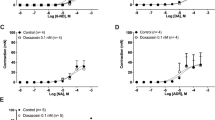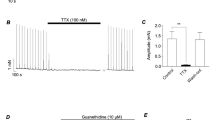Summary
Effects of exogenous prostaglandin (PG) E2 and PGI2 on testicular polymodal receptor activities were compared in in vitro recordings of single- or multi-fiber discharges from canine testis-spermatic nerve preparations. PGI2 up to 1.4×10−6 mol/l (cumulative method) or 1.0×10−5 mol/l (non-cumulative method) excited only weakly some of the receptors, and similar observations were made with PGE2. Both PGs applied cumulatively or non-cumulatively at concentrations above 1.4×10−8 mol/l augmented the response to bradykinin (9.4×10−8 mol/l) in more than half of the cases tested. The augmenting effect of PGE2 lasted longer than that of PGI2 both with the cumulative and the non-cumulative method. The degree of augmentation tended to increase dependent on concentration, but some cases showed no further increase or rather a decrease in augmentation by PGs at a ten times higher concentration, especially when PGs were applied cumulatively. A second challenge by PG after a short interval (2 min) did not induce augmentation. These phenomena were considered to be tachyphylaxis to PGs. Cross-tachyphylaxis to PGE2 and PGI2 was also observed. There was not much difference in excitatory and augmenting potencies between these two PGs, but there was a clear difference in the concentrations of the PGs necessary to induce excitation of polymodal receptors and to facilitate their response to bradykinin.
Similar content being viewed by others
References
Arturson G, Hamberg M, Jonsson C-E (1973) Prostaglandins in human burn blister fluid. Acta Physiol Scand 87:270–276
Ashby B (1988) Cyclic AMP turnover in response to prostaglandins in intact platelets: evidence for separate stimulatory and inhibitory prostaglandin receptors. Second Messengers Phosphoproteins 12:45–57
Ashby B (1989) Model of prostaglandin-regulated cyclic AMP metabolism in intact platelets: Examination of time-dependent effects on adenylate cyclase and phosphodiesterase activities. Mol Pharmacol 36:866–873
Bessou P, Perl ER(1969) Response of cutaneous sensory units with un-myelinated fibers to noxious stimuli. J Neurophysiol 32:1025–1043
Bombardieri S, Cattani P, Ciabattoni G, Di Munno O, Pasero G, Patrono C, Pinca E, Pugliese F (1981) The synovial prostaglandin system in chronic inflammatory arthritis: differential effects of steroidal and nonsteroidal antiinflammatory drugs. Br J Pharmacol 73:893–901
Brodie MJ, Hensby CN, Parke A, Gordon D (1980) Is prostacyclin the major proinflammatory prostanoid in joint fluid? Life Sci 27:603–608
Brown DA, Higashida H (1988) Membrane current responses of NG 108–15 mouse neuroblastoma × rat glioma hybrid cells to bradykinin. J Physiol (Loud) 397:167–184
Coleman RA, Humphrey PPA, Kennedy 1, Lumley P (1984) Prostanoid receptors - the development of a working classification. Trends Pharmacol Sci 5:303–306
Conklin BR, Burch RM, Steranka LR, Axelrod J (1988) Distinct bradykinin receptors mediate stimulation of prostaglandin synthesis by endothelial cells and fibroblasts. J Pharmacol Exp Ther 244:646–649
Dick C, Grennan DM (1976) Studies on the relative effects of prostaglandins, bradykinin, 5-hydroxytryptamine and histamine on the synovial microcirculation in dogs. Br J Pharmacol 56:313–316
Dray A, Bettaney J, Forster P, Perkins MN (1988) Bradykinin-induced stimulation of afferent fibres is mediated through protein kinase C. Neurosci Lett 91:301–307
Dusting GJ, Moncada S, Vane JR (1977) Disappearance of prostacyclin in the circulation of the dog. Br J Pharmacol 62:414–415
Ferreira SH (1972) Prostaglandins, aspirin-like drugs and analgesia. Nature (New Biol) 240:200–203
Ferreira SH, Nakamura M, Castro MSA (1978) The hyperalgesic effects of prostacyclin and prostaglandin E2. Prostaglandins 16:31–37
Higashida H, Brown DA (1986) Two polyphosphatidylinositide metabolites control two K+ currents in a neuronal cell. Nature 323:333–335
Higgs EA, Moncada S, Vane JR (1978) Inflammatory effects of prostacyclin (PGI2) and 6-oxo-PGF1α in the rat paw. Prostaglandins 16:153–162
Higgs GA, Moncada S, Salmon JA, Seager K (1983) The source of thromboxane and prostaglandins in experimental inflammation. Br J Pharmacol 79:863–868
Juan H (1978) Prostaglandins as modulators of pain. Gen Pharmacol 9:403–409
Juan H (1979) The pain enhancing effect of PGI2. Agents Actions 9:204–212
Katori M, Harada Y, Tanaka K, Miyazaki H, Ishibashi M, Yamashita Y (1980) Changes of prostaglandin and thromboxane levels in pleural fluid of rat carrageenin-induced pleurisy. In: Samuelsson B, Ramwell W, Paoletti R (eds) Advances in prostaglandin and thromboxane research, vol 8. Raven Press, New York, pp 1733–1737
Kumazawa T, Mizumura K (1980) Mechanical and thermal responses of polymodal receptors recorded from the superior spermatic nerve of dogs. J Physiol (Lond) 299:233–245
Kumazawa T, Mizumura K (1984) Abnormal activity of polymodal receptors induced by clioquinol (5-chloro-7-iodo-8-hydroxyquinoline). Brain Res 310:185–188
Kumazawa T, Mizumura K, Sato J (1987a) Thermally potentiated responses to algesic substances of visceral nociceptors. Pain 28:255–264
Kumazawa T, Mizumura K, Sato J (1987b) Response properties of polymodal receptors studied using in vitro testis superior spermatic nerve preparations of dogs. J Neurophysiol 57:702–711
Lefkowitz RJ, Stadel JM, Caron MG (1983) Adenylate cyclase-coupled beta-adrenergic receptors: structure and mechanisms of activation and desensitization. Annu Rev Biochem 52:159–186
Lembeck F, Juan H (1974) Interaction of prostaglandins and indomethacin with algesic substances. Naunyn-Schmiedeberg's Arch Pharmacol 285:301–313
Lewis AJ, Nelson DJ, Sygrue MF (1975) On the ability of prostaglandin E1 and arachidonic acid to modulate experimentally induced oedema in the rat paw. Br J Pharmacol 55:51–56
Mense S (1981) Sensitization of group IV muscle receptors to bradykinin by 5-hydroxytryptamine and prostaglandin E2. Brain Res 225:95 -105
Miller RJ (1987) Bradykinin highlights the role of phospholipid metabolism in the control of nerve excitability. Trends Neurosci 10:226–228
Miller OV, Gorman RR (1979) Evidence for distinct prostaglandin I2 and D2 receptors in human platelets. J Pharmacol Exp Ther 210:134–140
Mizumura K, Sato J, Kumazawa T (1986) Comparison of effects of prostaglandin-E2 and -I2 on activities of the canine visceral polymodal receptor. Nippon Seirigaku Zasshi 48:307
Mizumura K, Sato J, Kumazawa T (1987) Effects of prostaglandins and other putative chemical intermediaries on the activity of canine testicular polymodal receptors studied in vitro. Pflügers Arch 408:565–572
Mizumura K, Minagawa M, Tsujii Y, Kumazawa T (1990a) The effects of bradykinin agonists and antagonists on visceral polymodal receptor activities. Pain 40:221–227
Mizumura K, Minagawa M, Tsujii Y, Sato J, Kumazawa T (1990b) Differences in augmenting effects of various sensitizing agents on heat and bradykinin responses of the testicular polymodal receptor. Pain 5 [Suppl]:S 135
Moncada S, Flower RJ, Vane JR (1985) Prostaglandins, prostacyclin, thromboxane A2, and leukotrienes. In: Gilman AG, Goodman LS, Rall TW Murad F (eds) Goodman and Gilman's The pharmacological basis of therapeutics. Macmillan, New York, pp 661–673
Osugi T, Imaizumi T, Mizushima A, Uchida S, Yoshida H (1987) Phorbol ester inhibits bradykinin-stimulated inositol triphosphate formation and calcium mobilization in neuroblastoma × glioma hybrid NG108–15 cells. J Pharmacol Exp Ther 240:617–622
Roscher AA, Manganiello VC, Jelsema CL, Moss J (1984) Autoregulation of bradykinin receptors and bradykinin-induced prostacyclin formation in human fibroblasts. J Clin Invest 74:552–558
Salmon JA, Higgs GA, Vane JR, Bitensky L, Chayen J, Henderson B, Cashman B (1983) Synthesis of arachidonate cyclo-oxygenase products by rheumatoid and nonrheumatoid synovial lining in non-proliferative organ culture. Ann Rheum Dis 42:36–39
Schaible H-G, Schmidt RF (1988) Excitation and sensitization of fine articular afferents from cat's knee joint by prostaglandin E2. J Physiol (Lond) 403:91–104
Shamma MS, Fernandez-Botran R, Suzuki T (1988) PGE2-induced desensitization of adenylate cyclase of a murine macrophage-like cell line (P388D1). Prostaglandins 36:329–341
Sibley DR, Lefkowitz RJ (1985) Molecular mechanisms of receptor desensitization using the β-adrenergic receptor-coupled adenylate cyclase system as a model. Nature 317:124–129
Whalley ET, Clegg S, Stewart JM, Vavrek RJ (1987) The effect of kinin agonists and antagonists on the pain response of the human blister base. Naunyn-Schmiedeberg's Arch Pharmacol 336:652–655
Whittle BJR, Moncada S, Vane JR (1978) Comparison of the effects of prostacyclin (PGI2), prostaglandin E1 and D2 on platelet aggregation in different species. Prostaglandins 16:373–388
Author information
Authors and Affiliations
Additional information
Send offprint requests to T. Kumazawa at the above address
Rights and permissions
About this article
Cite this article
Mizumura, K., Sato, J. & Kumazawa, T. Comparison of the effects of prostaglandins E2 and I2 on testicular nociceptor activities studied in vitro. Naunyn-Schmiedeberg's Arch Pharmacol 344, 368–376 (1991). https://doi.org/10.1007/BF00183013
Received:
Accepted:
Issue Date:
DOI: https://doi.org/10.1007/BF00183013




